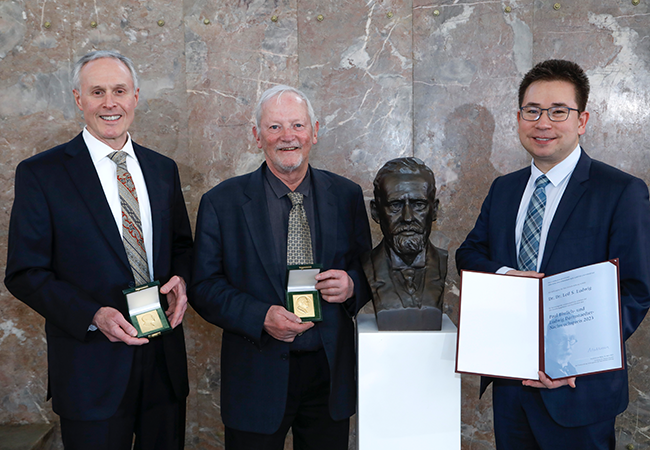The 2023 Paul Ehrlich and Ludwig Darmstaedter Prize, worth €120,000, will today be awarded to immunologists Frederick W. Alt and David G. Schatz in Frankfurt’s Paulskirche for their discovery of molecules and mechanisms that enable our immune system to perform the astonishing feat of recognizing billions of different bacterial, viral and other antigens on first contact. The Early Career Award goes to Leif S. Ludwig, biochemist and physician, for a method he has devised to analyze the origin and development of human blood cells, which also include the cells of the immune system.

Photo: Uwe Dettmar
Unlike more primitive organisms, jawed vertebrates like we humans not only have an innate immune system but also an adaptive one that is capable of preparing itself for all kinds of invaders. This is because – at some point in the course of evolution – one of our ancestors apparently succeeded in taming a DNA parasite that had implanted itself in his genome. This is how the parasite became the gene for an enzyme that advanced to become the command center of immunological diversity. This enzyme, RAG1/2, excises fragments from the DNA of certain chromosomes in maturing immune cells (lymphocytes) and recombines them to form functional genes in a random process. This somatic recombination multiplies the variability of antibodies and T cell receptors. It is a prerequisite for our body’s ability to build around ten billion different antibodies, although it only has about 20,000 protein blueprints in the form of genes. David G. Schatz discovered the RAG1/2 enzyme, Frederick W. Alt the enzymes that repair the DNA excised by it. “In decades of research, Alt and Schatz have shed light on the previously hidden evolution of our adaptive immunity, and in so doing they have raised our knowledge of the development of the immune system to a new level,” says Professor Thomas Boehm, Chairman of the Scientific Council of the Paul Ehrlich Foundation, commending the achievements of the two winners of the main prize.
The RAG1/2 enzyme is the motor for somatic recombination. Without it, neither functional B and T cells nor effective adaptive immunity can develop. Many cases of severe immunodeficiency are caused by mutations of the RAG genes, and some lymphomas and leukemias are associated with malfunctions of the enzymes encoded by these genes. This makes understanding not only the molecular mechanism but also their evolutionary origin and how they behave in the living cell nucleus even more important. According to Schatz’s findings, RAG1/2 originates from a gene that began jumping at will through the genome of our very early ancestors millions of years ago, like a kind of selfish parasite. In structural biology studies, Schatz has traced these jumps (transposons) over several stages of evolution. He has shown which biochemical tricks we vertebrates used to fix the jumping RAG1/2 gene at a certain position and harness it for the immune system.
As they migrate through the cell nucleus of immature lymphocytes, RAG enzymes draw together chromatin clusters, in which the DNA is coiled up in a space-saving way, temporarily and again and again to form recombination centers. There, they perform chromatin scanning, which Alt has described for the first time. They draw a chromatin thread, which can be over a million DNA letters long, through the recombination center like a loop. The result is that gene segments previously far apart are suddenly opposite each other and can be joined firmly together.
The B and T lymphocytes, on which acquired immunity rests, are components of our blood, in which at least 500 billion old cells per day are replaced by new ones in a healthy person. They originate from hematopoietic stem cells in the bone marrow and then mature on divergent developmental trajectories over several stages, like all other blood cells. Determining the resulting lineages and relationships is highly interesting for medicine, for example for identifying at which branch point a leukemia cell forms. Leif S. Ludwig, the winner of this year’s Early Career Award, has devised a method that opens up the possibility for the first time for medicine to do this relatively inexpensively, quickly and reliably. Ludwig’s method, which has already been tested on individual patients, combines the analysis of mutations in mitochondria with the latest technologies for the gene sequencing of individual cells.
2023 Paul Ehrlich and Ludwig Darmstaedter Prize > Infos
Dr. Frederick W. Alt is Charles A. Janeway Professor of Pediatrics and Director of the Program in Cellular and Molecular Medicine at Boston Children’s Hospital, a Howard Hughes Medical Institute Investigator,and Professor of Genetics at Harvard Medical School. Infos
Dr. David G. Schatz is Professor of Molecular Biophysics and Biochemistry at Yale University and Chairperson of the Department of Immunobiology at Yale School of Medicine. Infos
2023 Paul Ehrlich and Ludwig Darmstaedter Early Career Award > Infos
Dr. Leif S. Ludwig is the leader of the Emmy Noether Junior Research Group “Stem Cell Dynamics and Mitochondrial Genomics” at the Berlin Institute of Health at Charité and the Max Delbrück Center. Infos








